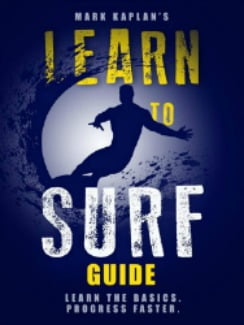What to Learn Surfing Foam Waves
Beginner surfers learn all the basics surfing foam waves. These waves are great for beginners because they form in shallow water, are easy to time, and can be caught with soft top surf boards.
The foam wave is the wave after the real wave breaks and can run from the outside where they can be big to the beach as they get smaller. The advantage for beginners is you see them coming and have time to get in position.
How to Begin
The beginner surfer gets in a position where the foam wave has enough power to push his surf board. As he sees the wave get within 20 feet, he rolls on top of the surf board and starts paddling easy.
When the wave is 3 feet away, he paddles hard as the wave hits the board and UNTIL the surf board is riding in front of the foam. This usually requires 3 to 5 more paddles.
The First Fundamentals
Once the surf board is in front of the foam wave, the surfer puts his hands on the board and begins his surfing pop up. The pop up consists of resting the hands near the chest first, then pushing up, then placing the back foot flat on the board under the butt, and then standing to put the front foot near the nose.
It is important to wind up in the right posture. When surfing foam waves, the surfer wants to surf straight to the beach without having to work. His posture has his feet shoulder width apart and his hips and shoulders square to the beach with knees flexed.
Skate boarders and snow boarders ride with a shoulder back and one forward, but in surfing this causes the surfer to fall off on the butt side. Everything must be square to the front with both hands in front of the surfers face so he can see them.
The Next Step
Once a surfer can roll over on the board, catch a wave, and ride straight to the beach, he can start to paddle out for bigger foam waves. Bigger waves have more weight and move faster, so having the fundamentals mastered is important. In between bigger foam waves, the surfer can start catching small real waves.
Real waves require more precise timing because they have to be caught as they arc. Rather than wait for a foam wave, the surfer paddles to where the real waves are arcing and lets the wave roll under the surf board. Then he paddles down the face and pop ups.
Have fun!
Learn More
For Oceanside Surf Lessons, see the Home Page
See the Post Surf Lessons Begin with Foam Waves
See the Post What You Learn in a 2 Hour Lesson
See the Post How to Progress in Surfing
See My Dry Land and In Water Demo video
See How to Catch a Green/Real Wave video
i have lowered my book and course prices for the lock down.
My New Surfing Course in an E-Book plus Demo Video
Get the 18 Chapter, 7,500 word Course that can prepare you for a lesson or give you the fundamentals if you are going to try it on your own. 10 years of teaching 350 students a year has given me the insights on the most precise measures you must follow for success. This course is what I teach on the dry land and in water instruction. The Course includes a 15 minute video on my dry land and in water demonstration. Only $4.95
Buy the E-book for $2.99. Learn to Surf (Different cover but same book)
Buy the Paperback on Amazon $6.95
Get Learn to Surf Course in 29 minute audio. Great prep for a lesson, reviewing after a lesson, learning on your own, refreshing after not having surfed for a while. See Table of Contents. Only $7.95

80 page Learn to Surf Book
![Surf Instructions Beginner to Advanced: Learn to Ride Waves by [Kaplan, Mark]](https://images-na.ssl-images-amazon.com/images/I/51HswFtoBQL.jpg)